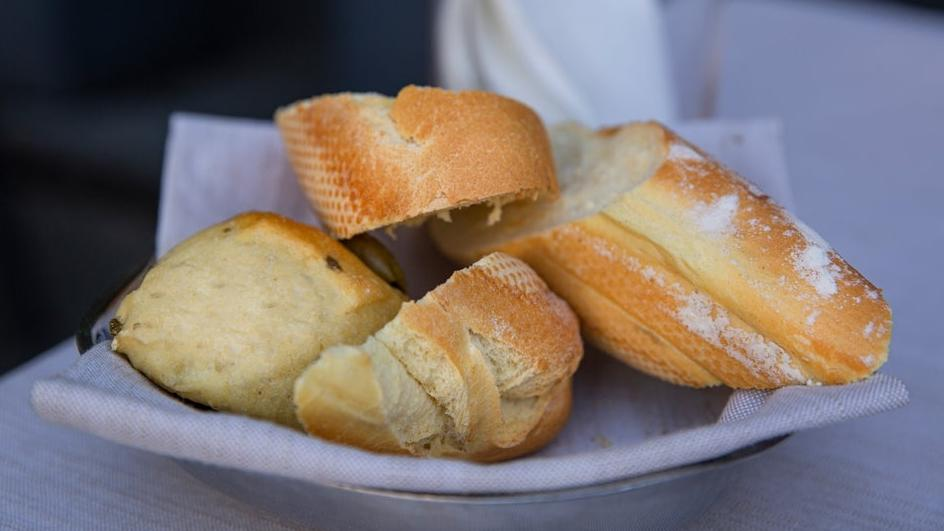Restaurant Bread Baskets Are Tearing Us Apart
Free bread baskets might be going away, and maybe that’s a good thing.
Perhaps it's because we finally appreciate how hard it is to keep a good SCOBY alive after making our own pandemic sourdough loaves. Perhaps it's because of inflation and the difficulties of keeping a restaurant open amidst a pandemic. Perhaps chefs and patrons alike are giving the perfect brioche or baguette their long overdue accolades. Whatever the reason, the "free bread" that restaurants typically serve before the meal has begun to make way for a "bread course" at certain top-tier restaurants around the country—that is, an appetizer that must be ordered and paid for, sometimes costing as much as an entree. Some people aren't happy about it.
Why is there a bread course?
From New York to Nashville, "fancy" restaurants are letting their chefs show off their baking skills in the form of bread courses, typically served before a savory meal at dinnertime, as Rachel Sugar reports for The New York Times. Sometimes it's your classic flour-based fare like rolls or slices of yeast-based breads, but my hometown hero, Gregory Gourdet, serves plantain buns at his Portland, Oregon restaurant, Kann, and many New York restaurants put twists on the classic dinner roll by incorporating flavors complementing the themes of the restaurant, such as curry, blue corn, and compound butters.
Sugar reports that the chefs charge for the so-called bread course to reflect the skill that goes into the creation of these baked goods, plus the complexity of the flavors beyond flour, salt, and yeast. Charging for the bread helps offset the ingredients, time, and labor it takes to create bread with quality befitting the meals that follow.
Restaurant patrons don’t want to pay for bread
The Times article has 450 comments at the time of this writing, and the Instagram post about the article from the @nytcooking account has 23,170 likes and over 300 comments. The traffic on the bread course post is a big uptick from the mint julep post preceding it, which has 3,893 likes and 70 comments, mostly consisting of opinions on how to shred ice. The bread basket commenters, meanwhile, are in a battle of the breads.
Critics of the practice of charging for bread don't want to pay for something that was previously free. "Bread in a restaurant should be a 'cost of doing business' and not a profit center," one commenter wrote. "Stop glorifying another disturbing rip-off that is looking to become 'normal' to captive customers." Many people agree.
Besides the principle of the thing, and that people find it plain rude, many critics of the bread course balk at the cost. Many of these restaurants charge upwards of $10 or even $15 for a couple of buns, a price some find greatly inflated, even in a market with significant inflation. They see it as a bad business move for restaurants already struggling to maintain patrons and joke about when they'll be charged for a "flight of waters." Guess they've never been to a restaurant where guests do get charged for water if they opt for bottled over tap.
The bread course has some ardent defenders
People in support of the bread course remind critics that Europe (ooh la la) has been charging for bread for quite some time. Other, less generous defenders say something to the effect of, hey, if you don't like it, get thee to an Olive Garden where you belong, or stay home and eat your amateur loaves. They emphasize that these are not your average stale white bread slices warmed up under a heat lamp, but skillfully crafted complements to the meal which often take more time and labor to prepare than the entrees.
Charging for bread is also more financially and environmentally sustainable, some people point out, since the restaurant will not be providing a big basket of bread to every table, from which many people will only eat a single roll and leave a large amount of food waste behind. After a commenter called Both Sides wrote that charging for bread (which uses wheat, which is over-farmed and unethically sourced) "seems exceedingly tone deaf and wasteful," a comment war broke out on the topic of various sustainable and regenerative farming methods. People feel strongly about their grains.
And, of course, it wouldn't be the internet in 2023 without some people commenting that it's good we're charging for bread because of how fat bread makes us. "With less than 12% of Americans metabolically healthy, it's probably a good thing these glucose spiking delicacies are pricey," wrote Sara T, who lists their location as "USA."
I don't know Sara T's credentials, but I'm having trouble finding an up-to-date peer-reviewed study to confirm that statistic, so I'd say don't worry about this sweeping generalization of the glycemic index of every loaf of bread created by every restaurant, unless Sara T happens to be your endocrinologist. Diet culture lurks among elite foodies as much as everywhere else.
At a certain point, the comments degraded into quoting The Menu, so that's where we are as a society. Restaurants can charge for bread if it's on The Menu, and we all know what happens when you defy the chef.
